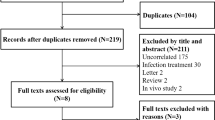Abstract
Negative pressure wound therapy (NPWT) has been used for several decades to assist in closure of large or necrotic wounds in general and orthopedic surgery and has recently been demonstrated to be a useful technique for complex spinal wounds. The authors discuss mechanisms of NPWT affecting wound healing, procedure notes for negative pressure wound vacuum placement, indications for negative pressure wound therapy, risks associated with negative pressure wound therapy, and care of patients undergoing NPWT. In appropriately selected patients, NPWT is a potential strategy to assist in closure of complex spinal wounds.
Access this chapter
Tax calculation will be finalised at checkout
Purchases are for personal use only
Similar content being viewed by others
References
Arens S, Schlegel U, Printzen G, Ziegler WJ, Perren SM, Hansis M (1996) Influence of materials for fixation implants on local infection. An experimental study of steel versus titanium DCP in rabbits. J Bone Joint Surg Br 78:647–651
Emery BE, Dixit R, Formby CC, Biedlingmaier JF (2003) The resistance of maxillofacial reconstruction plates to biofilm formation in vitro. Laryngoscope 113:1977–1982
Soultanis KC, Pyrovolou N, Zahos KA, Karaliotas GI, Lenti A, Liveris I, Babis GC, Soucacos PN (2008) Late postoperative infection following spinal instrumentation: stainless steel versus titanium implants. J Surg Orthop Adv 17:193–199
Ahmed R, Greenlee JD, Traynelis VC (2012) Preservation of spinal instrumentation after development of postoperative bacterial infections in patients undergoing spinal arthrodesis. J Spinal Disord Tech 25:299–302
Kale M, Padalkar P, Mehta V (2017) Vacuum-assisted closure in patients with post-operative infections after instrumented spine surgery: a series of 12 cases. J Orthop Case Rep 7:95–100
Adogwa O, Fatemi P, Perez E, Moreno J, Gazcon GC, Gokaslan ZL, Cheng J, Gottfried O, Bagley CA (2014) Negative pressure wound therapy reduces incidence of postoperative wound infection and dehiscence after long-segment thoracolumbar spinal fusion: a single institutional experience. Spine J 14:2911–2917
Lo Torto F, Ruggiero M, Parisi P, Borab Z, Sergi M, Carlesimo B (2017) The effectiveness of negative pressure therapy on infected wounds: preliminary results. Int Wound J 14(6):909–914
Sinha K, Chauhan VD, Maheshwari R, Chauhan N, Rajan M, Agrawal A (2013) Vacuum assisted closure therapy versus standard wound therapy for open musculoskeletal injuries. Adv Orthop 2013:245940
Ousey KJ, Atkinson RA, Williamson JB, Lui S (2013) Negative pressure wound therapy (NPWT) for spinal wounds: a systematic review. Spine J 13:1393–1405
Masden D, Goldstein J, Endara M, Xu K, Steinberg J, Attinger C (2012) Negative pressure wound therapy for at-risk surgical closures in patients with multiple comorbidities: a prospective randomized controlled study. Ann Surg 255:1043–1047
Horn PL, Ruth B, Kean JR (2007) Use of wound V.A.C. therapy in pediatric patients with infected spinal wounds: a retrospective review. Orthop Nurs 26:317–322
Kim JJ, Franczyk M, Gottlieb LJ, Song DH (2017) Cost-effective alternative for negative-pressure wound therapy. Plast Reconstr Surg Glob Open 5:e1211
Lee R, Street J, Boyd M, Fisher C, Dvorak M, Paquette S, Kwon B (2016) Management of post-operative spine wound infections using vacuum assisted closure (VAC) therapy. Spine J 16:S68–S69
Jones GA, Butler J, Lieberman I, Schlenk R (2007) Negative-pressure wound therapy in the treatment of complex postoperative spinal wound infections: complications and lessons learned using vacuum-assisted closure. J Neurosurg Spine 6:407–411
Husted D, Grauer JN, Hilibrand AS (2004) The use of wound vacuums in the management of postoperative wound infections. Semin Spine Surg 16:182–187
Zehnder SW, Place HM (2007) Vacuum-assisted wound closure in postoperative spinal wound infection. Orthopedics 30:267–272
Karaaslan F, Erdem S, Mermerkaya MU (2015) Wound management with vacuum-assisted closure in postoperative infections after surgery for spinal stenosis. Int Med Case Rep J 8:7–11
Mehbod AA, Ogilvie JW, Pinto MR, Schwender JD, Transfeldt EE, Wood KB, Le Huec JC, Dressel T (2005) Postoperative deep wound infections in adults after spinal fusion: management with vacuum-assisted wound closure. J Spinal Disord Tech 18:14–17
Ploumis A, Mehbod AA, Dressel TD, Dykes DC, Transfeldt EE, Lonstein JE (2008) Therapy of spinal wound infections using vacuum-assisted wound closure: risk factors leading to resistance to treatment. J Spinal Disord Tech 21:320–323
Anghel EL, Kim PJ, Attinger CE (2016) A solution for complex wounds: the evidence for negative pressure wound therapy with instillation. Int Wound J 13(Suppl 3):19–24
Lall RR, Wong AP, Lall RR, Lawton CD, Smith ZA, Dahdaleh NS (2015) Evidence-based management of deep wound infection after spinal instrumentation. J Clin Neurosci 22:238–242
Topkoru BC, Kaner T (2015) Negative pressure wound therapy (VAC) for the treatment of spinal surgical site infections. World Spinal Column J 1:46–49
Sporns PB, Zimmer S, Hanning U, Zoubi T, Wölfer J, Herbort M, Schwindt W, Niederstadt T (2015) Acute tonsillar cerebellar herniation in a patient with traumatic dural tear and VAC therapy after complex trauma. Spine J 15:e13–e16
Wild T, Rahbarnia A, Kellner M, Sobotka L, Eberlein T (2010) Basics in nutrition and wound healing. Nutrition 26:862–866
Canavese F, Krajbich JI (2010) Use of vacuum assisted closure in instrumented spinal deformities for children with postoperative deep infections. Indian J Orthop 44:177–183
Author information
Authors and Affiliations
Corresponding author
Editor information
Editors and Affiliations
Rights and permissions
Copyright information
© 2018 Springer International Publishing AG
About this chapter
Cite this chapter
Cheng, J.S., Nasser, R., Staarmann, B., Yang, G., Mejia-Munne, J.C., Gibson, J. (2018). Negative Pressure Wound Therapy for the Treatment of Complex Spinal Wounds. In: Shiffman, M., Low, M. (eds) Burns, Infections and Wound Management. Recent Clinical Techniques, Results, and Research in Wounds, vol 2. Springer, Cham. https://doi.org/10.1007/15695_2018_115
Download citation
DOI: https://doi.org/10.1007/15695_2018_115
Published:
Publisher Name: Springer, Cham
Print ISBN: 978-3-030-10685-0
Online ISBN: 978-3-030-10686-7
eBook Packages: MedicineMedicine (R0)




